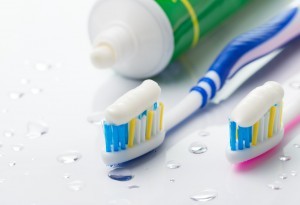 When you’re looking for a new toothbrush, it’s easy to think they all look the same. Sure, some many have a cool curvy or rubberized handle, and some may have all sorts of colorful bristles that claim this and that. But, is there really much of a difference among toothbrush bristles? Quite a bit! We’ve got the lowdown on everything you need to know about the most important part of the toothbrush, and how you can find just the right brush for your needs.
When you’re looking for a new toothbrush, it’s easy to think they all look the same. Sure, some many have a cool curvy or rubberized handle, and some may have all sorts of colorful bristles that claim this and that. But, is there really much of a difference among toothbrush bristles? Quite a bit! We’ve got the lowdown on everything you need to know about the most important part of the toothbrush, and how you can find just the right brush for your needs.
Hard
Often called “Firm” on toothbrush packaging, these bristles are very stiff and rigid and sometimes claim to clean teeth more thoroughly. However, hard bristle brushes are not recommended by the ADA, as they can scratch the teeth and can damage the gums, potentially leading to receding gums and infection. Firm bristles also don’t have the flexibility to reach all areas of the tooth and can leave debris behind. So, it’s best to leave the hard bristle brushes for cleaning the grout, not cleaning your teeth.
Medium
If you have a chronic plaque problem, a medium-firm toothbrush could be right for you. Studies have shown that a medium toothbrush can remove slightly more plaque than a soft toothbrush, but scratched the surrounding gum tissues. If you find that you’re constantly battling with plaque, talk with your dentist about whether or a medium toothbrush is right for you, and learn how to brush with it safely.
Soft
A soft-bristle toothbrush is recommended as best for most people by the ADA. The soft, flexible bristles are able to cover all areas of the tooth and gums as well as all the little nooks and crannies, without damaging the soft tissues. Just remember not to brush too hard (soft, circular motions are key!) and replace your brush every 3-4 months, and you’re on your way to a brighter smile.
Polishing Cup
Many toothbrushes, especially electric toothbrush heads, are sold with a small rubber cup in the middle of the head. This cup can help get rid of surface stains and plaque while polishing the teeth, just like the polishing cup the dentist uses during your annual cleaning. If you’re looking for a smoother smile, look for this feature in your next toothbrush.
Multilevel Bristles
These toothbrushes contain a mixture of long, short, and sometimes diagonal bristles. Having mixed bristle lengths can help you clean hard-to-reach areas in the teeth. For example, the short bristles will be able to dig into the nooks and crannies on the surfaces of the teeth, while the long and diagonal bristles can clean the sides and get into the gaps between teeth. Longer bristles can also help clean along the gum line, an area which many people miss or neglect.
Diamond-Shaped Bristles
Bristles set into a diamond-shaped head can be helpful if you have trouble cleaning your molars. The narrow top edge of the toothbrush can slip more easily into those back corners and allow you to clean all sides of the molars and gums, which is harder to do with a broader toothbrush. Diamond-shaped bristles can also be good for people who gag when cleaning their molars, as the narrower shape puts less pressure in the back of the mouth.
Color-Changing Bristles
The ADA recommends that you change your manual toothbrush or electric toothbrush head every 3-4 months. This is because even the best toothbrush bristles wear down and because the toothbrush is so frequently wet, it can harbor bacteria over time. However, most people simply forget to replace their toothbrush. Well, the excuses are over! Most toothbrushes now have color-changing bristles, which turn from blue (or another dark color) to white. Once the bristles are white, its time to change the toothbrush or toothbrush head. It’s that easy!
Who knew there were some may different kinds of toothbrush bristles out there? We hope this little guide makes it easier to find the right brush for you. When in doubt, ask your dentist. Or, drop us a line — we’re happy to help you out!







Leave a Reply